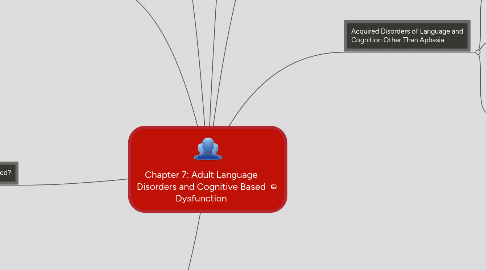
1. Types and Defining Characteristics of Aphasia
1.1. Broca's Aphasia: Nonfluent, effortful articulation, telegraphic speech(mostly nouns and verbs), short phrases, impaired prosody, apraxia of speech.
1.2. Transcortical Motor Aphasia: Nonfluent, difficulty initiating speech, paraphasias, short utterances, good repetition.
1.3. Global: Nonfluent, delayed, or no speech initiation and output, naming and word-finding problems.
1.4. Wernicke's: Fluent, meaningless speech and jargon, paraphasias, naming difficulties.
1.5. Transcortical Sensory: Fluent, meaningless speech and jargon, paraphasias, naming difficulties.
1.6. Conduction: Fluent, imitation problems, naming difficulties, normal prosody and articulation
2. How is Aphasia Classified?
2.1. Behavorial Symptoms: The language deficients are differentiated by their impact of fluency, motor output, comprehension, repetition, naming, and reading and writing.
2.2. Fluency: Some people with aphasia have almost no fluency due to impairments in verbal output (this type of aphasia is called Nonfluent. However, some are considered fluent and called Sensory Aphasia.
2.3. Motor Output: Particularly when speech is nonfluent, motor systems involved with speech are compromised. This occurs when areas of the brain controlling motor planning and programming are injured.
2.4. Language Comprehension (also called Auditory Comprehension): This is the ability to understand spoken language. Most individuals with Aphasia experience some degree of auditory comprehension deficit.
2.5. Repetition: The ability to repeat verbal stimuli is a major factor in differentiating among the aphasias. Repetition abilities alone cannot differentiate between fluent and nonfluent or receptive and expressive aphasia profiles. However, after these general groupings are established, an individual's repetition skills provide further details about the exact nature of the person's language impairment.
2.6. Naming (or word retrieval): This is the ability to retrieve and produce a target word during conversation. "Anomia" meaning "no name" is the term used to describe word-finding problems. Everyone has problems remembering words sometimes but more serious deficits are typical of Aphasia.
2.7. Reading and Writing: Often, reading and writing deficients parallel the verbal language deficits. For example, persons who are nonfluent in spoken language frequently exhibit nonfluent oral reading.
3. What is Aphasia?
3.1. Aphasia is a language disorder that is acquired sometime after an individual has developed language competence
3.1.1. Aphasia literally means "the absense of language" but people affected by asphasia can exhibit a broad range of difficulties from mild to severe.
3.2. It is the result of injury to the language functions of the brain. Common injuries include: stroke, infectious diseases (meningitis or encephalitis), tumors, exposure to toxins, and nutritional disorders.
3.2.1. Of these injuries, stroke is the most common.
4. Aphasia vs. other communication disorders
4.1. Some common misconceptions about aphasia are:
4.1.1. 1: It is not a developmental disorder. it is an acquired disruption in the language system following neurological injury
4.1.2. 2: It is not a psychiatric problem. Even though the symptoms of both may appear similar, a language deficit is not the same as a psychological disturbance.
4.1.3. 3: It is not a motor speech disorder such as Dysarthia and Apraxia. Aphasia is language-based, not motor based but the symptoms can similarly affect a persons ability to communicate effectively.
5. How is Aphasia Identified?
5.1. 1. Is aphasia present? 2. If so, what type or syndrome of aphasia is indicated by the symptoms? 3. What treatment plan will be most beneficial? 4. What is the prognosis for recovery? 5. Are any referrals to other professionals needed?
5.1.1. When evaluating an individual with suspected aphasia, the SLP seeks to answer this series of questions.
6. Typical Items Included in Aphasia Tests
6.1. Spontaneous Speech: Answering questions; Describing a picture; Participating in informal or structured conversations
6.2. Auditory Comprehension: Answering yes/no questions; Pointing to objects or pictures as they are named; Following directions
6.3. Repetition: Repeating real words, phrases, and sentences; Repeating nonsense words and phrases
6.4. Naming: Naming objects and pictures; Completing phrases; Naming items in a category; Providing names of general categories
6.5. Reading: Reading words, phrases, sentences, and paragraphs
6.6. Writing: Copying letters, words, and sentences; Writing from dictation; Writing about fictional or real experiences
7. Acquired Disorders of Language and Cognition Other Than Aphasia
7.1. Right-Hemisphere Dysfunction: Neurological damage to brain tissue in the right hemisphere due to loss of nutrients and oxygen to the brain.
7.1.1. Caused by stroke, illness and disease
7.1.1.1. Lack of attention to the left side of the body including visual field; Difficulty recognizing faces; Compromised pragmatics; Wordy expression, including tangents; Lack of awareness of communicative and cognitive impairments; problems with higher-level abstract thinking and language use; Possible dysarthia and dysphagia.
7.2. Traumatic Brain Injury: neurological damage to brain tissue due to closed or open head injury
7.2.1. Caused by motor vehicle accident, fall, recreational sports accident, or act of violence
7.2.1.1. Possible significant personality changes; Widespread language expression an comprehension problems, including expressing ideas, comprehending what others say, using and expressing humor, displaying emotions, and engaging in higher-level abstract uses of language and cognition, particularly memory.
7.3. Dementia: Gradual onset of declines in cognition, language, and daily living functions due to progressive central nervous system dysfunction
7.3.1. Caused by Neurological disease (Huntington's, Parkinson's, Pick's, Creutzfeldt-Jakob) and multiple strokes
7.3.1.1. Memory impairment (both short- and long-term; Impairment in cognitive skills (abstract thought, judgement, and executive functions) Presence of aphasia, apraxia or agnosia
